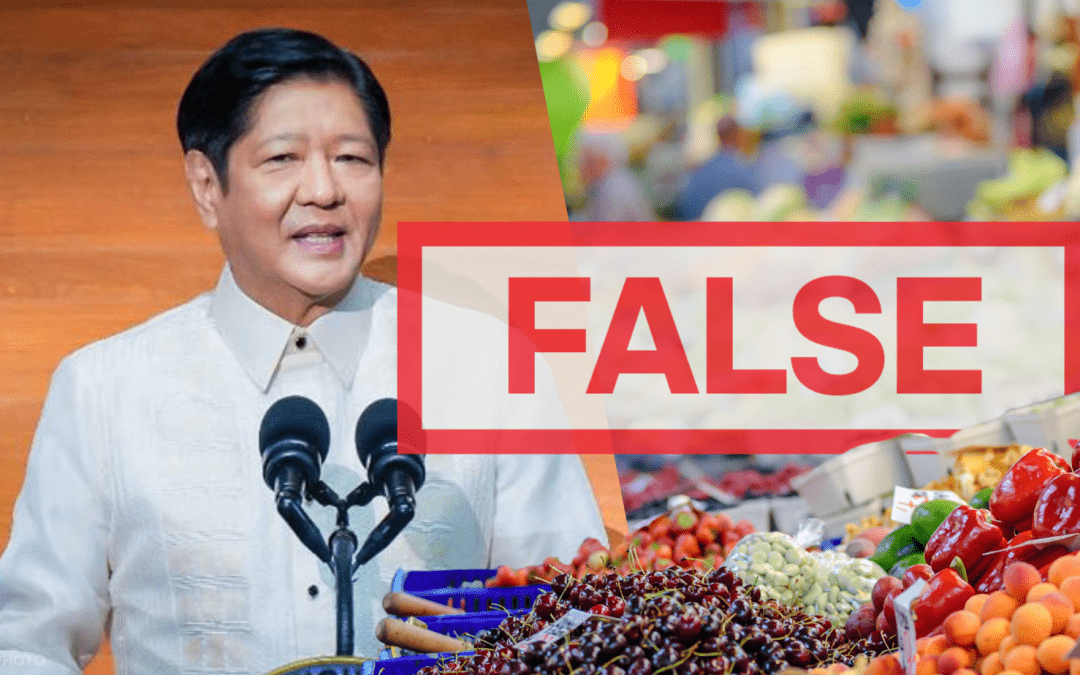
Without offering any statistical basis, President Ferdinand Marcos Jr. claimed in his second State of the Nation Address (SONA) that prices in various sectors went down in recent months.

CLAIM: Prices of goods in different sectors went down in recent months
RATING: FALSE
Without offering any statistical basis, President Ferdinand Marcos Jr. claimed in his second State of the Nation Address (SONA) that prices of rice, meat, fish, vegetables, and sugar have been reduced.
“Sa mga nakalipas na buwan, nakita natin ang pagbaba ng presyo ng bilihin sa iba’t ibang mga sektor. Napatunayan natin na kayang maipababa ang presyo ng bigas, karne, isda, gulay, at asukal,” he said on July 24.
The latest inflation statistics belie this claim however, as the data point to a declining rate of increase in prices rather than an absolute decline in prices.
June 2023 inflation stood at 5.4 percent, which means that last month, prices rose by more than 5 percent compared with the same month last year. While prices did not decrease, the pace of growth was slower compared with 6.1 percent in May 2023.
Marcos Jr. actually mentioned this in his 2nd SONA: “Inflation rate is moving in the right direction. From 8.7% in January, our inflation has continued to ease up in all regions, settling now at 5.4% for June. What this means is that in spite of all the difficulties, we are transforming the economy. We are stabilizing the prices of all critical commodities.”
But the same inflation report does not support his claim in the SONA of a reduction in prices in various sectors.
According to the Philippine Statistics Authority (PSA), there was an annual increase, albeit slower, “in the heavily-weighted food and non-alcoholic beverages at 6.7 percent in June 2023 from 7.4 percent in the previous month.”
Food and non-alcoholic beverages were the main contributors to inflation, with a 47.3-percent share or 2.6 percentage points, according to the PSA.
Food inflation, which takes into account only food items, stood at 6.7 percent in June 2023, meaning to say food prices rose nearly 7 percent year-on-year.
However, the June 2023 reading was a deceleration for the fifth consecutive month, according to official data. In May 2023, food inflation stood at 7.5 percent. In June 2022, the figure was 6.4 percent.
Components or food inflation showed the same trend of deceleration, as follows:
- meat and other parts of slaughtered land animals, 0.3 percent in June 2023 from 3.2 percent in May 2023;
- fruits and nuts, 11.4 percent from 14.3 percent;
- sugar, confectionery and desserts, 28.9 percent from 31.6 percent;
- corn, 5.3 percent from 5.9 percent;
- flour, bread and other bakery products, pasta products, and other cereals, 11.0 percent from 11.4 percent;
- milk, other dairy products and eggs, 11.2 percent from 12.1 percent;
- oils and fats, 5.6 percent from 8.5 percent; and
- ready-made food and other food products not elsewhere classified, 8.5 percent from 9.0 percent.
Why should we trust inflation data? Inflation is derived from the Consumer Price Index (CPI), a “major statistical series used for economic analysis and as a monitoring indicator of government economic policy,” according to the PSA.
Collection of price data is done systematically and reliably. According to the PSA’s CPI primer, six price quotations for each commodity in its “market basket” are gathered on the first five days of the month and in the middle of each month for selected cities.
At most five price quotations are gathered in Metro Manila. “Price collection for food is done weekly in 14 markets. For the non-food commodities, 14 markets are surveyed, and price collection is done on the first five days of the month and during the middle of each month,” according to the PSA.
Collection is different at the province level. According to the primer: “Two price quotations are collected at the provincial capital while four other price quotations are collected from the municipalities outside the capital during the first five days of the month. However, only two price quotations are collected from the provincial capital during the middle of each month.”
In the case of fuel products, six price quotations are collected daily from each sample market for each commodity in 15 sample areas in Metro Manila.
“Outside Metro Manila, two price quotations for each commodity are collected in the provincial capital every Friday, while four other price quotations for each commodity are collected once a month from the municipalities outside the capital during the first five days of the month. For selected cities, six price quotations are collected every Friday,” according to the PSA.
Government statisticians take the average of these price readings in computing the CPI. – PressOnePH
PressOne.PH is a verified signatory of the the Code of Principles of the International Fact -Checking Network (IFCN) at Poynter. The code of principles of the International Fact-Checking Network is a series of commitments organizations abide by to promote excellence in fact-checking. We believe nonpartisan and transparent fact-checking can be a powerful instrument of accountability journalism..
PressOne.PH believes that fact-checking is essential to combating misinformation and disinformation, and in informing and educating citizens and voters. Read more of PressOne.PH’s Fact-Checking Policy by clicking here.
The public is welcome to send feedback or requests for fact-checks at factcheck@pressone.ph.


FACT-CHECK: Marcos Jr. gives contradicting analyses of consumer prices in 2nd SONA
Without offering any statistical basis, President Ferdinand Marcos Jr. claimed in his second State of the Nation Address (SONA) that prices in various sectors went down in recent months.

FACT-CHECK: Japanese manga character photo used for a quote of GMA Network CEO Felipe Gozon
A Facebook account used a photo of a Japanese manga character instead of GMA Network CEO Felipe Gozon on an ABS-CBN News quote card.

CNN Philippines did not publish any story about Leachon’s supposed drug for joint, back pain
A fake website made the false claim that an unregistered drug was supposedly formulated and endorsed by Dr. Tony Leachon.
The post FACT-CHECK: Marcos Jr. gives contradicting analyses of consumer prices in 2nd SONA appeared first on #PressOnePH.

0 Comments